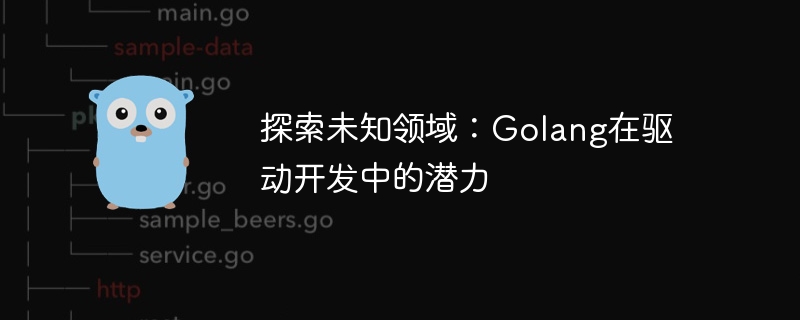Home >Backend Development >Golang >Exploring Uncharted Territories: Golang's Potential in Driver Development
Exploring Uncharted Territories: Golang's Potential in Driver Development
- WBOYWBOYWBOYWBOYWBOYWBOYWBOYWBOYWBOYWBOYWBOYWBOYWBOriginal
- 2024-03-20 15:18:04586browse

In recent years, as an emerging programming language that has attracted widespread attention, Golang (Go language) has shown strong potential in various fields. Among them, as a more specialized field, driver development has always been one of the fields that programmers consider extremely challenging and technical. In this field, Golang has also demonstrated its strong performance capabilities and potential. This article will explore the potential of Golang in driver development and provide specific code examples.
First of all, let us briefly understand what "driver development" is. Driver development, as the name suggests, is the development process of writing programs for hardware or underlying systems. This development method requires programmers to interact directly with the hardware, and requires the program to be efficient, real-time and reliable. Traditionally, driver development is mainly done using C/C language because the code written in these two languages has high performance and strong portability. However, with the development of Golang, more and more developers are discovering that using Golang in the field of driver development also has great advantages.
- Golang’s powerful concurrency features
As a modern programming language, Golang is inherently equipped with powerful concurrency features. In driver development, the program is required to efficiently communicate with hardware devices and perform real-time data processing. Golang's concurrency features allow programmers to easily implement concurrent operations such as multi-threading and coroutines, thereby better utilizing the performance advantages of multi-core processors and ensuring program efficiency and real-time performance.
The following is a simple Golang code example that shows how to create a concurrent goroutine in Golang and communicate with a hardware device:
package main
import (
"fmt"
"time"
)
func communicateWithHardware(device string, ch chan string) {
for {
// Simulate communication with hardware devices
data := "Send data to " device
ch <- data
time.Sleep(time.Second) // Simulate real-time data processing
}
}
func main() {
ch := make(chan string)
go communicateWithHardware("Device A", ch)
for {
select {
case data := <-ch:
fmt.Println("Received data:", data)
}
}
}In the above code, we define a function named communicateWithHardware to simulate communication with the hardware device and send data to the channel ch . In the main function, we create a goroutine to call the communicateWithHardware function to achieve concurrent communication with the hardware device. By using goroutines and channels, we can efficiently complete communication with hardware devices and real-time data processing operations.
- Golang’s excellent cross-platform features
Another area that gives Golang an advantage in driver development is its excellent cross-platform features. Driver development usually requires that the program can run on different hardware platforms and operating systems and have good portability. The cross-platform nature of Golang allows programmers to easily write code once and run it on different platforms without doing much extra work.
The following is a simple Golang code example that shows how to use Golang's cross-platform features to communicate with hardware devices on different operating systems:
package main
import (
"fmt"
"runtime"
)
func main() {
fmt.Println("Operating System:", runtime.GOOS)
//Perform different operations according to different operating systems
switch runtime.GOOS {
case "linux":
// Communicate with hardware devices under Linux system
fmt.Println("Communicating with hardware on Linux")
case "windows":
// Communicate with hardware devices under Windows system
fmt.Println("Communicating with hardware on Windows")
case "darwin":
// Communicate with hardware devices under Mac OS system
fmt.Println("Communicating with hardware on Mac OS")
default:
fmt.Println("Unsupported operating system")
}
}In the above code, we use the runtime.GOOS function to obtain the operating system information of the current program running, and perform corresponding operations according to different operating systems. In this way, we can easily communicate with hardware devices on different operating systems and ensure program portability.
- Golang’s rich standard library and third-party library support
Finally, Golang also has rich standard library and third-party library support, providing more for driver development choice and convenience. Golang's standard library contains many functional modules related to network communication, data processing, etc., which can help programmers quickly develop programs that communicate with hardware devices. In addition, Golang's open source community has also developed many excellent third-party libraries, such as github.com/google/gopacket, etc., which can help programmers complete driver development work more efficiently.
To sum up, Golang has shown strong potential in driver development, mainly reflected in concurrency features, cross-platform features and rich library support. By using Golang, programmers can better complete communication with hardware devices, data processing and real-time operations, improving program performance and reliability. Of course, in practical applications, programmers also need to choose appropriate technologies and tools based on specific needs and scenarios to better utilize Golang's potential in driver development.
The above is the detailed content of Exploring Uncharted Territories: Golang's Potential in Driver Development. For more information, please follow other related articles on the PHP Chinese website!

